Xiaohan Lin
LeanGeo: Formalizing Competitional Geometry problems in Lean
Aug 20, 2025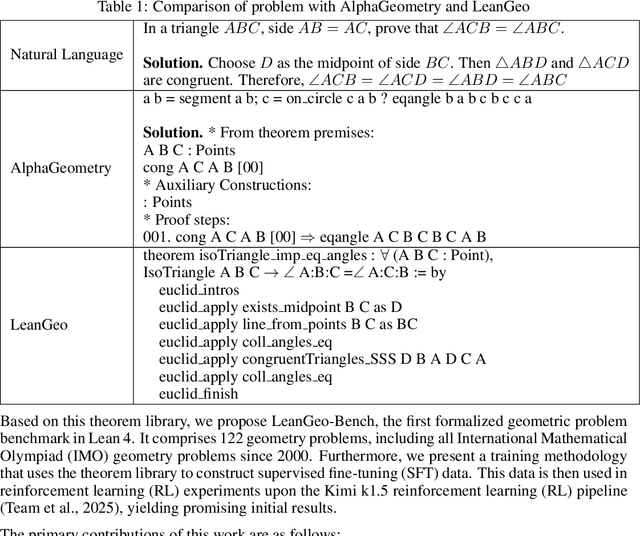
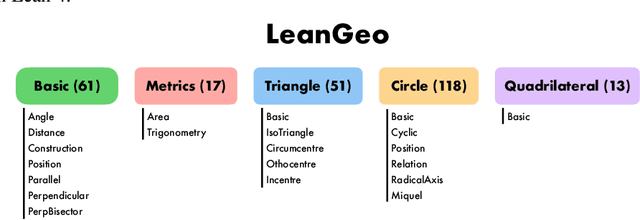
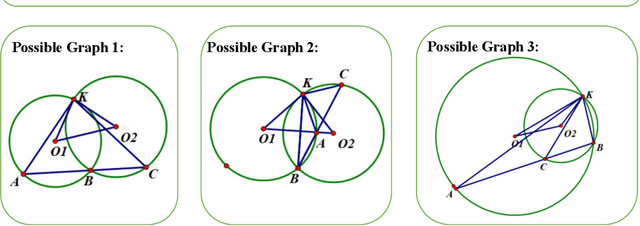
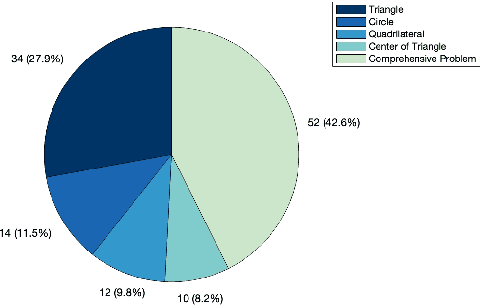
Abstract:Geometry problems are a crucial testbed for AI reasoning capabilities. Most existing geometry solving systems cannot express problems within a unified framework, thus are difficult to integrate with other mathematical fields. Besides, since most geometric proofs rely on intuitive diagrams, verifying geometry problems is particularly challenging. To address these gaps, we introduce LeanGeo, a unified formal system for formalizing and solving competition-level geometry problems within the Lean 4 theorem prover. LeanGeo features a comprehensive library of high-level geometric theorems with Lean's foundational logic, enabling rigorous proof verification and seamless integration with Mathlib. We also present LeanGeo-Bench, a formal geometry benchmark in LeanGeo, comprising problems from the International Mathematical Olympiad (IMO) and other advanced sources. Our evaluation demonstrates the capabilities and limitations of state-of-the-art Large Language Models on this benchmark, highlighting the need for further advancements in automated geometric reasoning. We open source the theorem library and the benchmark of LeanGeo at https://github.com/project-numina/LeanGeo/tree/master.
Kimi K2: Open Agentic Intelligence
Jul 28, 2025Abstract:We introduce Kimi K2, a Mixture-of-Experts (MoE) large language model with 32 billion activated parameters and 1 trillion total parameters. We propose the MuonClip optimizer, which improves upon Muon with a novel QK-clip technique to address training instability while enjoying the advanced token efficiency of Muon. Based on MuonClip, K2 was pre-trained on 15.5 trillion tokens with zero loss spike. During post-training, K2 undergoes a multi-stage post-training process, highlighted by a large-scale agentic data synthesis pipeline and a joint reinforcement learning (RL) stage, where the model improves its capabilities through interactions with real and synthetic environments. Kimi K2 achieves state-of-the-art performance among open-source non-thinking models, with strengths in agentic capabilities. Notably, K2 obtains 66.1 on Tau2-Bench, 76.5 on ACEBench (En), 65.8 on SWE-Bench Verified, and 47.3 on SWE-Bench Multilingual -- surpassing most open and closed-sourced baselines in non-thinking settings. It also exhibits strong capabilities in coding, mathematics, and reasoning tasks, with a score of 53.7 on LiveCodeBench v6, 49.5 on AIME 2025, 75.1 on GPQA-Diamond, and 27.1 on OJBench, all without extended thinking. These results position Kimi K2 as one of the most capable open-source large language models to date, particularly in software engineering and agentic tasks. We release our base and post-trained model checkpoints to facilitate future research and applications of agentic intelligence.
CombiBench: Benchmarking LLM Capability for Combinatorial Mathematics
May 06, 2025Abstract:Neurosymbolic approaches integrating large language models with formal reasoning have recently achieved human-level performance on mathematics competition problems in algebra, geometry and number theory. In comparison, combinatorics remains a challenging domain, characterized by a lack of appropriate benchmarks and theorem libraries. To address this gap, we introduce CombiBench, a comprehensive benchmark comprising 100 combinatorial problems, each formalized in Lean~4 and paired with its corresponding informal statement. The problem set covers a wide spectrum of difficulty levels, ranging from middle school to IMO and university level, and span over ten combinatorial topics. CombiBench is suitable for testing IMO solving capabilities since it includes all IMO combinatorial problems since 2000 (except IMO 2004 P3 as its statement contain an images). Furthermore, we provide a comprehensive and standardized evaluation framework, dubbed Fine-Eval (for $\textbf{F}$ill-in-the-blank $\textbf{in}$ L$\textbf{e}$an Evaluation), for formal mathematics. It accommodates not only proof-based problems but also, for the first time, the evaluation of fill-in-the-blank questions. Using Fine-Eval as the evaluation method and Kimina Lean Server as the backend, we benchmark several LLMs on CombiBench and observe that their capabilities for formally solving combinatorial problems remain limited. Among all models tested (none of which has been trained for this particular task), Kimina-Prover attains the best results, solving 7 problems (out of 100) under both ``with solution'' and ``without solution'' scenarios. We open source the benchmark dataset alongside with the code of the proposed evaluation method at https://github.com/MoonshotAI/CombiBench/.
Kimina-Prover Preview: Towards Large Formal Reasoning Models with Reinforcement Learning
Apr 15, 2025Abstract:We introduce Kimina-Prover Preview, a large language model that pioneers a novel reasoning-driven exploration paradigm for formal theorem proving, as showcased in this preview release. Trained with a large-scale reinforcement learning pipeline from Qwen2.5-72B, Kimina-Prover demonstrates strong performance in Lean 4 proof generation by employing a structured reasoning pattern we term \textit{formal reasoning pattern}. This approach allows the model to emulate human problem-solving strategies in Lean, iteratively generating and refining proof steps. Kimina-Prover sets a new state-of-the-art on the miniF2F benchmark, reaching 80.7% with pass@8192. Beyond improved benchmark performance, our work yields several key insights: (1) Kimina-Prover exhibits high sample efficiency, delivering strong results even with minimal sampling (pass@1) and scaling effectively with computational budget, stemming from its unique reasoning pattern and RL training; (2) we demonstrate clear performance scaling with model size, a trend previously unobserved for neural theorem provers in formal mathematics; (3) the learned reasoning style, distinct from traditional search algorithms, shows potential to bridge the gap between formal verification and informal mathematical intuition. We open source distilled versions with 1.5B and 7B parameters of Kimina-Prover
ProtTeX: Structure-In-Context Reasoning and Editing of Proteins with Large Language Models
Mar 13, 2025Abstract:Large language models have made remarkable progress in the field of molecular science, particularly in understanding and generating functional small molecules. This success is largely attributed to the effectiveness of molecular tokenization strategies. In protein science, the amino acid sequence serves as the sole tokenizer for LLMs. However, many fundamental challenges in protein science are inherently structure-dependent. The absence of structure-aware tokens significantly limits the capabilities of LLMs for comprehensive biomolecular comprehension and multimodal generation. To address these challenges, we introduce a novel framework, ProtTeX, which tokenizes the protein sequences, structures, and textual information into a unified discrete space. This innovative approach enables joint training of the LLM exclusively through the Next-Token Prediction paradigm, facilitating multimodal protein reasoning and generation. ProtTeX enables general LLMs to perceive and process protein structures through sequential text input, leverage structural information as intermediate reasoning components, and generate or manipulate structures via sequential text output. Experiments demonstrate that our model achieves significant improvements in protein function prediction, outperforming the state-of-the-art domain expert model with a twofold increase in accuracy. Our framework enables high-quality conformational generation and customizable protein design. For the first time, we demonstrate that by adopting the standard training and inference pipelines from the LLM domain, ProtTeX empowers decoder-only LLMs to effectively address diverse spectrum of protein-related tasks.
ProTeX: Structure-In-Context Reasoning and Editing of Proteins with Large Language Models
Mar 11, 2025Abstract:Large language models have made remarkable progress in the field of molecular science, particularly in understanding and generating functional small molecules. This success is largely attributed to the effectiveness of molecular tokenization strategies. In protein science, the amino acid sequence serves as the sole tokenizer for LLMs. However, many fundamental challenges in protein science are inherently structure-dependent. The absence of structure-aware tokens significantly limits the capabilities of LLMs for comprehensive biomolecular comprehension and multimodal generation. To address these challenges, we introduce a novel framework, ProTeX, which tokenizes the protein sequences, structures, and textual information into a unified discrete space. This innovative approach enables joint training of the LLM exclusively through the Next-Token Prediction paradigm, facilitating multimodal protein reasoning and generation. ProTeX enables general LLMs to perceive and process protein structures through sequential text input, leverage structural information as intermediate reasoning components, and generate or manipulate structures via sequential text output. Experiments demonstrate that our model achieves significant improvements in protein function prediction, outperforming the state-of-the-art domain expert model with a twofold increase in accuracy. Our framework enables high-quality conformational generation and customizable protein design. For the first time, we demonstrate that by adopting the standard training and inference pipelines from the LLM domain, ProTeX empowers decoder-only LLMs to effectively address diverse spectrum of protein-related tasks.
FVEL: Interactive Formal Verification Environment with Large Language Models via Theorem Proving
Jun 20, 2024


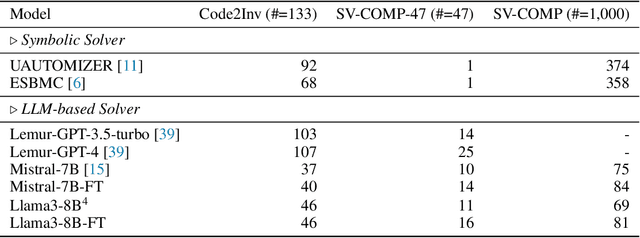
Abstract:Formal verification (FV) has witnessed growing significance with current emerging program synthesis by the evolving large language models (LLMs). However, current formal verification mainly resorts to symbolic verifiers or hand-craft rules, resulting in limitations for extensive and flexible verification. On the other hand, formal languages for automated theorem proving, such as Isabelle, as another line of rigorous verification, are maintained with comprehensive rules and theorems. In this paper, we propose FVEL, an interactive Formal Verification Environment with LLMs. Specifically, FVEL transforms a given code to be verified into Isabelle, and then conducts verification via neural automated theorem proving with an LLM. The joined paradigm leverages the rigorous yet abundant formulated and organized rules in Isabelle and is also convenient for introducing and adjusting cutting-edge LLMs. To achieve this goal, we extract a large-scale FVELER3. The FVELER dataset includes code dependencies and verification processes that are formulated in Isabelle, containing 758 theories, 29,125 lemmas, and 200,646 proof steps in total with in-depth dependencies. We benchmark FVELER in the FVEL environment by first fine-tuning LLMs with FVELER and then evaluating them on Code2Inv and SV-COMP. The results show that FVEL with FVELER fine-tuned Llama3- 8B solves 17.39% (69 -> 81) more problems, and Mistral-7B 12% (75 -> 84) more problems in SV-COMP. And the proportion of proof errors is reduced. Project page: https://fveler.github.io/.
ATG: Benchmarking Automated Theorem Generation for Generative Language Models
May 05, 2024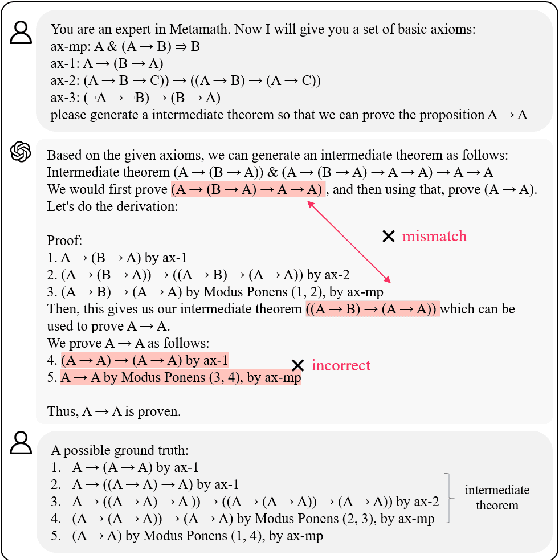
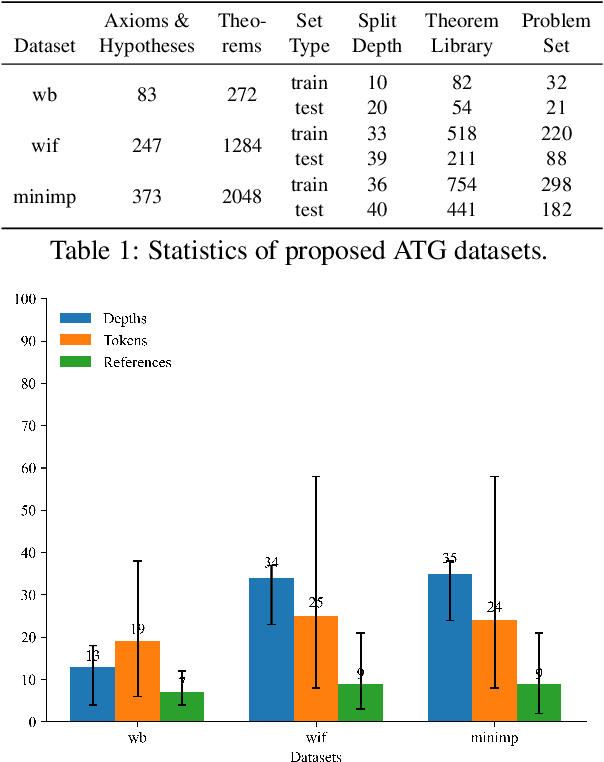
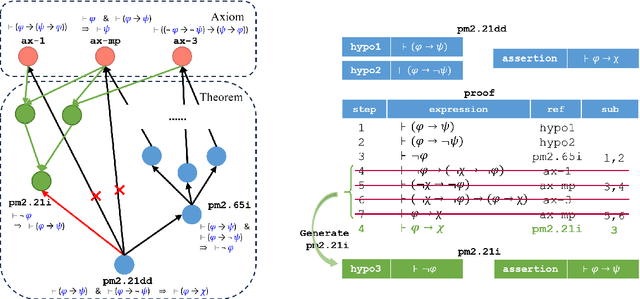

Abstract:Humans can develop new theorems to explore broader and more complex mathematical results. While current generative language models (LMs) have achieved significant improvement in automatically proving theorems, their ability to generate new or reusable theorems is still under-explored. Without the new theorems, current LMs struggle to prove harder theorems that are distant from the given hypotheses with the exponentially growing search space. Therefore, this paper proposes an Automated Theorem Generation (ATG) benchmark that evaluates whether an agent can automatically generate valuable (and possibly brand new) theorems that are applicable for downstream theorem proving as reusable knowledge. Specifically, we construct the ATG benchmark by splitting the Metamath library into three sets: axioms, library, and problem based on their proving depth. We conduct extensive experiments to investigate whether current LMs can generate theorems in the library and benefit the problem theorems proving. The results demonstrate that high-quality ATG data facilitates models' performances on downstream ATP. However, there is still room for current LMs to develop better ATG and generate more advanced and human-like theorems. We hope the new ATG challenge can shed some light on advanced complex theorem proving.
MUSTARD: Mastering Uniform Synthesis of Theorem and Proof Data
Feb 14, 2024Abstract:Recent large language models (LLMs) have witnessed significant advancement in various tasks, including mathematical reasoning and theorem proving. As these two tasks require strict and formal multi-step inference, they are appealing domains for exploring the reasoning ability of LLMs but still face important challenges. Previous studies such as Chain-of-Thought (CoT) have revealed the effectiveness of intermediate steps guidance. However, such step-wise annotation requires heavy labor, leading to insufficient training steps for current benchmarks. To fill this gap, this work introduces MUSTARD, a data generation framework that masters uniform synthesis of theorem and proof data of high quality and diversity. MUSTARD synthesizes data in three stages: (1) It samples a few mathematical concept seeds as the problem category. (2) Then, it prompts a generative language model with the sampled concepts to obtain both the problems and their step-wise formal solutions. (3) Lastly, the framework utilizes a proof assistant (e.g., Lean Prover) to filter the valid proofs. With the proposed MUSTARD, we present a theorem-and-proof benchmark MUSTARDSAUCE with 5,866 valid data points. Each data point contains an informal statement, an informal proof, and a translated formal proof that passes the prover validation. We perform extensive analysis and demonstrate that MUSTARD generates validated high-quality step-by-step data. We further apply the MUSTARDSAUCE for fine-tuning smaller language models. The fine-tuned Llama 2-7B achieves a 15.41% average relative performance gain in automated theorem proving, and 8.18% in math word problems. Codes and data are available at https://github.com/Eleanor-H/MUSTARD.
Machine-Learned Invertible Coarse Graining for Multiscale Molecular Modeling
May 02, 2023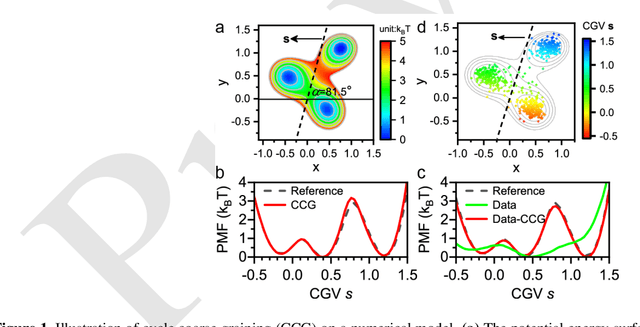
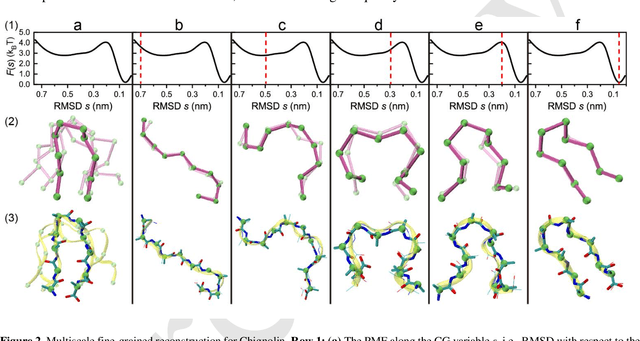
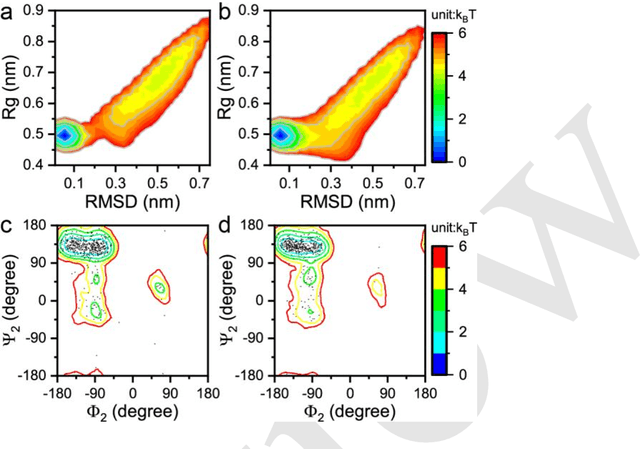
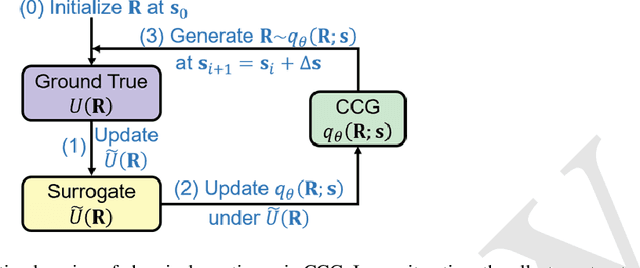
Abstract:Multiscale molecular modeling is widely applied in scientific research of molecular properties over large time and length scales. Two specific challenges are commonly present in multiscale modeling, provided that information between the coarse and fine representations of molecules needs to be properly exchanged: One is to construct coarse grained (CG) models by passing information from the fine to coarse levels; the other is to restore finer molecular details given CG configurations. Although these two problems are commonly addressed independently, in this work, we present a theory connecting them, and develop a methodology called Cycle Coarse Graining (CCG) to solve both problems in a unified manner. In CCG, reconstruction can be achieved via a tractable optimization process, leading to a general method to retrieve fine details from CG simulations, which in turn, delivers a new solution to the CG problem, yielding an efficient way to calculate free energies in a rare-event-free manner. CCG thus provides a systematic way for multiscale molecular modeling, where the finer details of CG simulations can be efficiently retrieved, and the CG models can be improved consistently.
 Add to Chrome
Add to Chrome Add to Firefox
Add to Firefox Add to Edge
Add to Edge